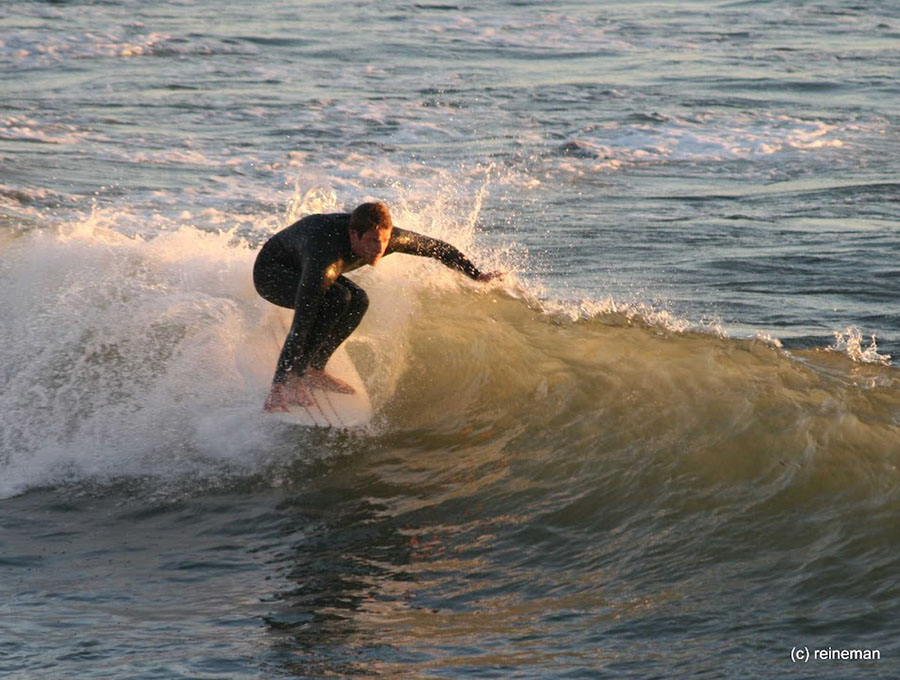 June 5, 2023 - There’s no question that climate change is affecting conditions for millions of surfers around the world, but a recent study co-authored by CSU Channel Islands (CSUCI) Assistant Professor of Environmental Science & Resource Management (ESRM) Dan Reineman suggests that our actions in response to climate change might have an even more profound and immediate effect than climate change itself.
June 5, 2023 - There’s no question that climate change is affecting conditions for millions of surfers around the world, but a recent study co-authored by CSU Channel Islands (CSUCI) Assistant Professor of Environmental Science & Resource Management (ESRM) Dan Reineman suggests that our actions in response to climate change might have an even more profound and immediate effect than climate change itself.
“Climate change is going to affect surf breaks, but those effects will be metered out slowly over the coming decades—many surfers may not notice them,” Reineman said. “By contrast, if coastal communities react to those potential climate change impacts by radically altering their coastlines—installing a seawall, for example—it could have an immediate and potentially existential effect on the quality of a wave.”
Waves that surfers ride are incredibly complex phenomena depending on many processes, Reineman explained, adding that waves form in far distant storms, travel thousands of miles across oceans, and break in different ways depending on the shape and composition of the shoreline. Through emissions of greenhouse gases and modifications to our coasts, humans are altering these processes.
 To give surfers, policymakers, and the public a way to assess the vulnerability of specific surf breaks, Reineman and his co-author, coastal scientist Nick Sadrpour (formerly with the California Sea Grant program), developed a Surf Break Vulnerability-Climate Change Assessment Tool, which they dubbed the SurfCAT.
To give surfers, policymakers, and the public a way to assess the vulnerability of specific surf breaks, Reineman and his co-author, coastal scientist Nick Sadrpour (formerly with the California Sea Grant program), developed a Surf Break Vulnerability-Climate Change Assessment Tool, which they dubbed the SurfCAT.
The tool is designed to empower people with their own knowledge about their coastlines. “By carefully considering a set of important characteristics for a surf break, including its sensitivity to tides, swell direction, sea floor, and others, users can determine its vulnerability to different impacts from our climate change,” Reineman said.
Reineman and Sadrpour spent more than four years reviewing hundreds of studies on the science underlying key oceanographic processes, from wave formation to wave breaking, and from the scale of whole oceans to local beaches, plus all the recent research on how climate change will likely affect these processes.
By gathering and organizing the results of this scholarship, they developed a framework, the SurfCAT, and key conclusions about the potential effects of climate change on surfing. The research was published in Shore & Beach, the quarterly, peer-reviewed journal of the American Shore and Beach Preservation Association (ASBPA).
“Our goal was to provide a comprehensive review of how climate change would affect waves for surfing and to provide this review in a format that was not only rigorous and scientific, but also accessible to the average surfer, beachgoer, or local decision maker,” Sadrpour said.
This summer, Reineman will attend a summit of managers from surfing reserves around the world to share the study results and SurfCAT.
To read the study, visit: https://asbpa.org/publications/shore-and-beach/shore-beach-in-2023-vol-91/the-impacts-of-climate-change-on-surfing-resources.
